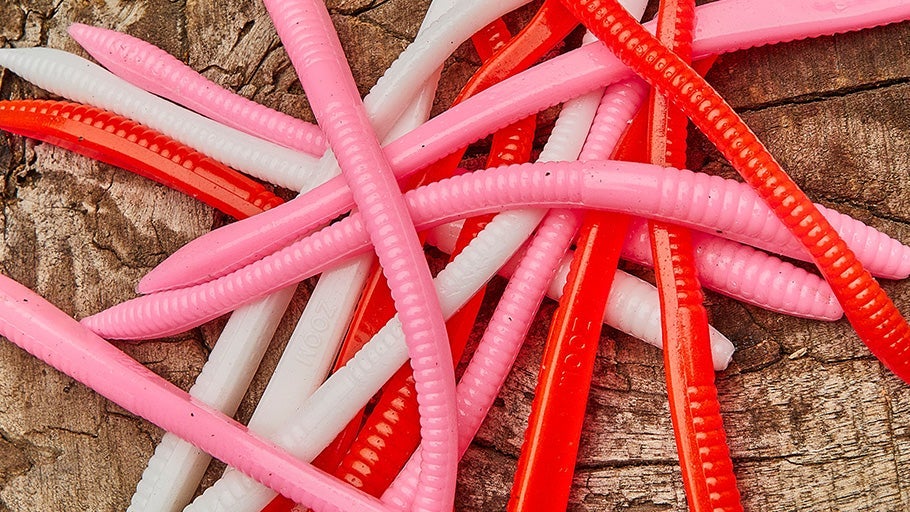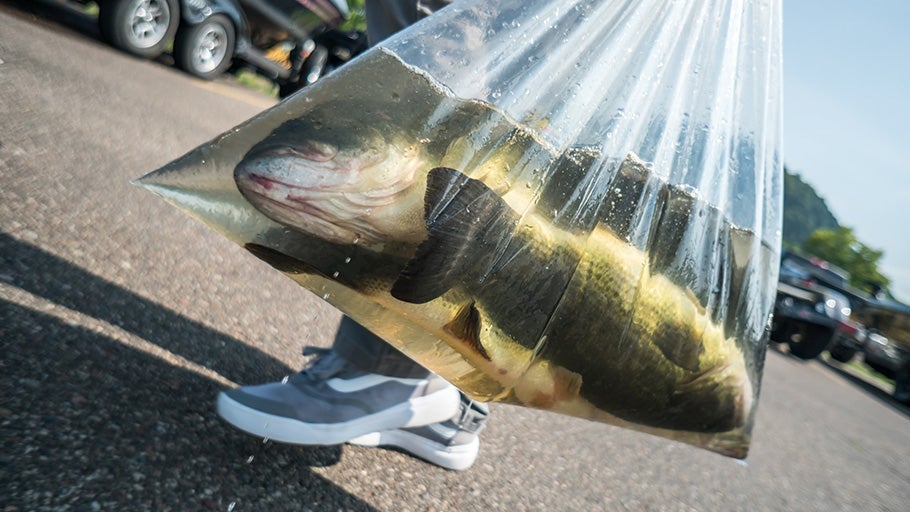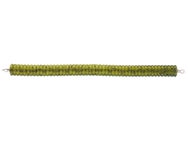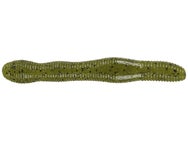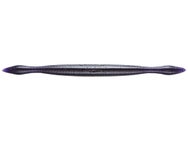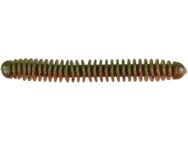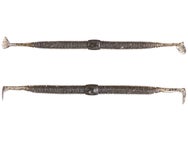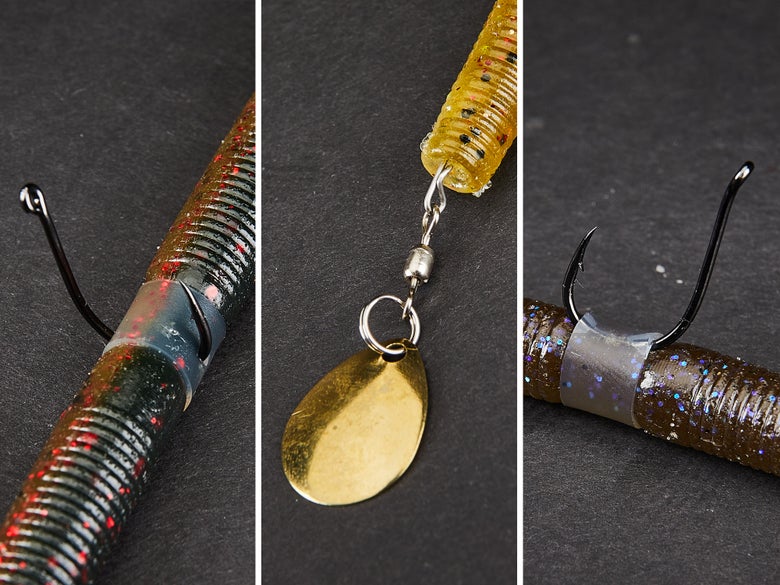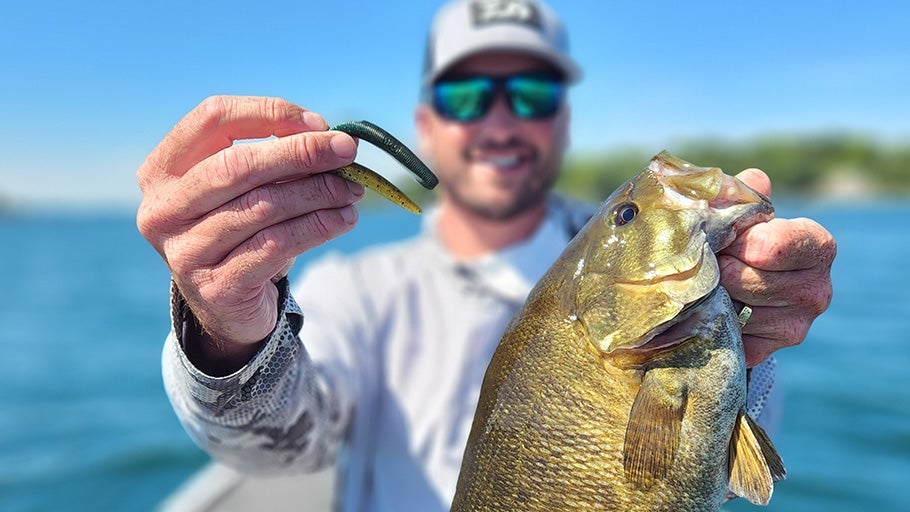
Weightless Wacky Worm Gear Guide
The slow-sinking and suspending action of the weightless wacky worm make it a deadly choice anytime the fish are shallow, and when the bite gets tough few lures produce with the same effectiveness. A powerful lure during the Spring and early Summer, weightless wacky worms are ideal for skipping into shallow areas where bass are bedding, tempting fry guarders, or targeting post-spawn fish that have moved off the bank and are keyed in on the shad spawn.
Arguably the most non-intrusive lure in bass fishing, the subtle action of a weightless wacky worm allows anglers to make pinpoint pitches to targets with a stealthy and methodical approach. In this article, we will provide a gear recommendation for both casting and spinning setups, discuss rigging methods, hook positioning, modifications, and look into why imparting less action during the retrieve is key to getting more bites with the weightless wacky worm.
Wacky Worm Rods
Due to their light nature, weightless wacky worms require a rod with a soft enough tip to make long and accurate casts, but they also demand a fair amount of backbone to set the hook. Start with a spinning rod that is 7' - 7'3" in length with a medium heavy power so you can pull fish away from cover, ideally with a fast taper so you can easily load the rod tip to skip and cast your worm with precision. Spinning rods are often preferred for skipping weightless worms, but when fishing heavy cover or an oversized stick worm, you may need to reach for the added power of a medium heavy to heavy power casting rod in the same size range.
Wacky Worm Reels
Bites can range from aggressive around actively feeding fish to barely noticeable around slow-moving post-spawners in recovery mode, so faster gear ratios are preferred so you can catch up to undetected bites and deliver a solid hookset. Try using a 3000-size spinning reel or larger for weightless wacky worms, as every turn of the reel handle will pick up more line than spinning reels with a smaller spool, and the larger handle will also provide increased cranking power for big fish. If you prefer using casting gear for this technique, a 100-150-size casting reel with a 7:1 – 8:1 gear ratio will pick up line quickly and offer plenty of line capacity.
Wacky Worm Line
Most anglers look for added strength of a no-stretch braided mainline in the 10-20lb range to deliver the power needed for positive hooksets and use fluorocarbon leaders of 8-15lb test to help disguise their presentation. Brightly colored braided fishing lines are preferred to provide high visibility for easier bite detection, as weightless worms often get bit when falling slowly on a slackline, and a small jump in the line is the only indicator. When using casting gear, you are typically fishing a larger worm or around heavy cover, so most anglers prefer straight fluorocarbon in 12-20lb test and will choose line size based on water clarity, species, and thickness of the cover present.
Modifications & Rigging
To create the unique action that generates movement from both the head and tail, you'll need to rig your finesse hook through the middle of the worm. Unfortunately, this type of hook positioning also causes the plastic to tear easily, so to maximize the longevity of each worm use an O-ring or silicone tube to reinforce the worm and extend the life of your soft plastics. Experiment with rigging your hook point parallel with the worm for a more weedless approach around heavy cover, or if you need to improve your hook-up ratios, rig the hook directly through the tubing to expose the hook point. If you are fishing around thick vegetation try using a wacky hook with a weedguard to reduce hang-ups, and don't forget to spice up your worm’s appeal with some dip n dye, skirting, or even a worm blade.
Retrieve Technique
If you know you are around fish but can't get them to react to your moving baits, the weightless wacky worm is a great alternative for picking apart areas when the fish are lethargic, spooky, or unwilling to chase. Dubbed the "do-nothing" worm, the magic of the wacky worm lies in the subtle fluttering action it produces as it descends slowly through the water column, which is often when the bite occurs. Cast towards your target, let the worm fall slowly to the bottom and pay close attention to your line. If you don't get bit as the worm is falling, give it a couple of hops off the bottom, reel up, and repeat.
Try targeting shallow water areas with vegetation, deep water access near spawning grounds, docks, brush piles, or reeds. Pay attention to the sink rate of your stick baits, as the rate of fall can differ greatly from one manufacturer to the next. The slower sinking action of worms with less salt is ideal for skipping under docks and overhanging cover, while worms packed with salt fall faster and allow anglers to work them more aggressively.
Colors
The copious amount of color options make it easy to get overwhelmed when choosing stick baits, so it’s best to find a few colors that you are successful with and stock up! Green pumpkin has a reputation for performing well throughout the country and in all types of water clarity, but typically you want to lean toward natural colors in clear water and switch to dark or bright variations for dirty water situations. As shad and bluegill start to become more prominent in shallow waters during the Spring, don't be afraid to introduce some natural shad patterns or colors with purple and orange accents to match the hatch.
While many anglers prefer power fishing with moving baits, the weightless wacky worm can still be found on many tournament angler's boat decks, as it's easily one of the most effective soft plastics in bass fishing when the fish aren’t actively feeding. Whether you are a beginner or advanced angler, the weightless wacky worm deserves a spot in your lineup with its ability to stay effective throughout most of the year and catch fish from 10 inches to 10 pounds!

